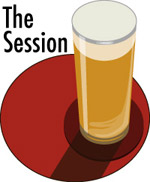 BeerTaster.ca is hosting the 45th gathering of The Session, and the topic is #45: Wheat Beers. Not sure how the turnout will be, given little gathering in Boulder this weekend, but head on over to BeerTaster.ca for the wrapup.
BeerTaster.ca is hosting the 45th gathering of The Session, and the topic is #45: Wheat Beers. Not sure how the turnout will be, given little gathering in Boulder this weekend, but head on over to BeerTaster.ca for the wrapup.
I could write a book about wheat beers. Wait, I already have. Making it all the more difficult to pick one beer to write about, or even a type from a particular region.
So instead, a little about wheat itself, what it contributes to wheat beers, what it tastes like. But don’t expect a definitive answer. As German brewing literature indicates, wheat by itself has little influence on esters and other fermentation by-products. It’s yeast quickly changes that.
I asked the question many times over in researching BWW and never walked away with anything definitive. Bob Hansen, manager of technical services at Briess Malt & Ingredients Company, had a pretty good answer, saying, “Wheaty, earthy. It is different, but you’d be surprised how non-different it is. You can use wheat to make a pilsner.”
Steven Pauwels at Boulevard Brewing in Kansas City said he likes the character unmalted wheat adds. “It brings a crispness that’s hard to describe. A little drier, makes a beer more drinkable,” he said.
Darron Welch, brewmaster at Pelican Pub & Brewery in Pacific City, Oregon, views wheat as a facilitator. “I think it has a bready flavor,” he said. “Because it is foam positive it changes how yeast brings other flavors into play.”
And Jean-Francois Gravel of Dieu du Ciel! in Montreal, who provided a recipe for wit beer, added: “To me, wheat has a very delicate bready flavor with some acidity or refreshing tartness. I think the barley has more pronounced grain flavor and a sweeter perception. If you eat raw wheat and malted wheat you will see the difference of texture right away because the malted wheat is more crumbly and easy to crush. But the flavor difference between the unmalted and malted wheat is very subtle. The malted wheat will have a bit more . . . malty flavor.”
Did I mention I’m brewing a wheat wine on Sunday? Not sure what session that might be ready for.
